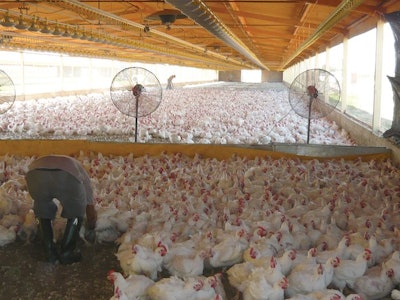
Several factors, from harvesting to stunning, can contribute to reduced yields and lower final output at the poultry processing plant. However, where bird handling and bird stress are concerned, these factors are easy to remedy.
Harvesting on farm
Broilers must be kept as calm as possible during harvesting.
On some farms, dividers are not installed at the start of rearing and, because of this, birds must be physically separated when capture takes place. To do this, the harvesting team usually brings in large sheets or frames with plastic meshes, moving very quickly to catch and load the broilers as fast as possible.
This can stress and panic the birds and they will try to escape, flapping their wings and rising one on top of the other, which can result their skin being torn.
To reduce this stress, dividers should be installed across the narrowest space of a poultry house and, in a house of 15 meters width, they can be installed in two sections and moved using conventional wheelbarrow which has been adapted to have a third wheel.
Once in place, these frames can be moved manually or electrically as cages are filled. The aim is to keep the remaining birds as close as possible to the harvesting team, preventing time lost chasing birds, stressing the birds, and tiring the workers, who will then work more slowly.
Harvesting is usually carried out by carrying the birds by one leg, or by holding the birds by the body with the wings held tightly to it. During the former method, there is the risk that birds will be harmed due to wing flapping. However, the latter method takes longer, requires more workers and has an impact on costs, although this will be compensated for by the lower number of birds rejected at the processing plant.
Various recent studies have looked at whether birds could be carried by one leg, but all have found there will always be at least some wing flapping. But even working at normal speed, i.e. quickly, flapping can be kept to a minimum if workers keep their arms straight and do not swing the birds.
At the processing plant
There are also numerous circumstances at the processing plant that can lead to stress and consequent losses.
It is worth remembering that the area where the crated or caged birds are loaded onto transporters should be completely dark, and as quiet as possible if stress levels are to be kept low. When birds are hung onto the shackles, they must be handled carefully. Poor ergonomic design of the area can work against this.
A poorly installed breast comforter can lead to problems in a variety of ways. Should the structure not be sufficiently rigid, and move when touched, the birds will not fully relax.
It must also be properly adjusted, with the surface protruding slightly beyond an imaginary line formed by the shackles. Once birds are hanging on the shackles and are released by the workers, they must come into direct contact with the comforter.
There needs to be a minimum distance of 10 centimeters between the bottom of the shackles and the top of the breast comforter, as this will prevent the hanging team from hurting their fingers when they place the broilers’ legs into the shackles.
There should be no sharp turns in the trajectory of the overhead conveyor, as they could result in the birds losing contact with the comforter and starting to flap again.

Wing flapping will be the result of birds experiencing stress and lead to damaged wings and harm to breast muscle. (Eduardo Cervantes Lopez)
Dumper
At some processing plants, birds are unloaded using a dumper system. Upon unloading, sliding down the ramp that leads to the conveyor belt will lead to birds falling on one other with consequential wing flapping and damage. They will start to relax on the way to the hanging area but, on arrival at the revolving platform, stress levels and wing flapping will increase once again.
It is not only the wings that may be damaged. Given that breast muscles control wing movements, they may suffer bleeds and bruising.
Stunning
It is important that the route from the hanging area to the stunner is dark to keep birds calm. Broilers will enter the stun bath in one of two ways: either rising up a ramp or descending in the same way as when carcasses enter the scalder. In the former, intense flapping may occur if equipment has not been properly set up. Should preshock occur, birds will lift their heads, will not be stunned and continue flapping as they remain conscious.
Slaughter
If birds are slaughtered while still conscious, the pain they experience will again result in wing flapping. Welfare will be affected and, given the high speeds at which plants increasingly work, it may be almost impossible to remove them from the line prior to slaughter and rehang them on the shackles.
Any issues that have occurred from harvesting through to evisceration will now become apparent, and those birds that have been poorly handled will be either partially or wholly rejected, reducing the final yield.

















